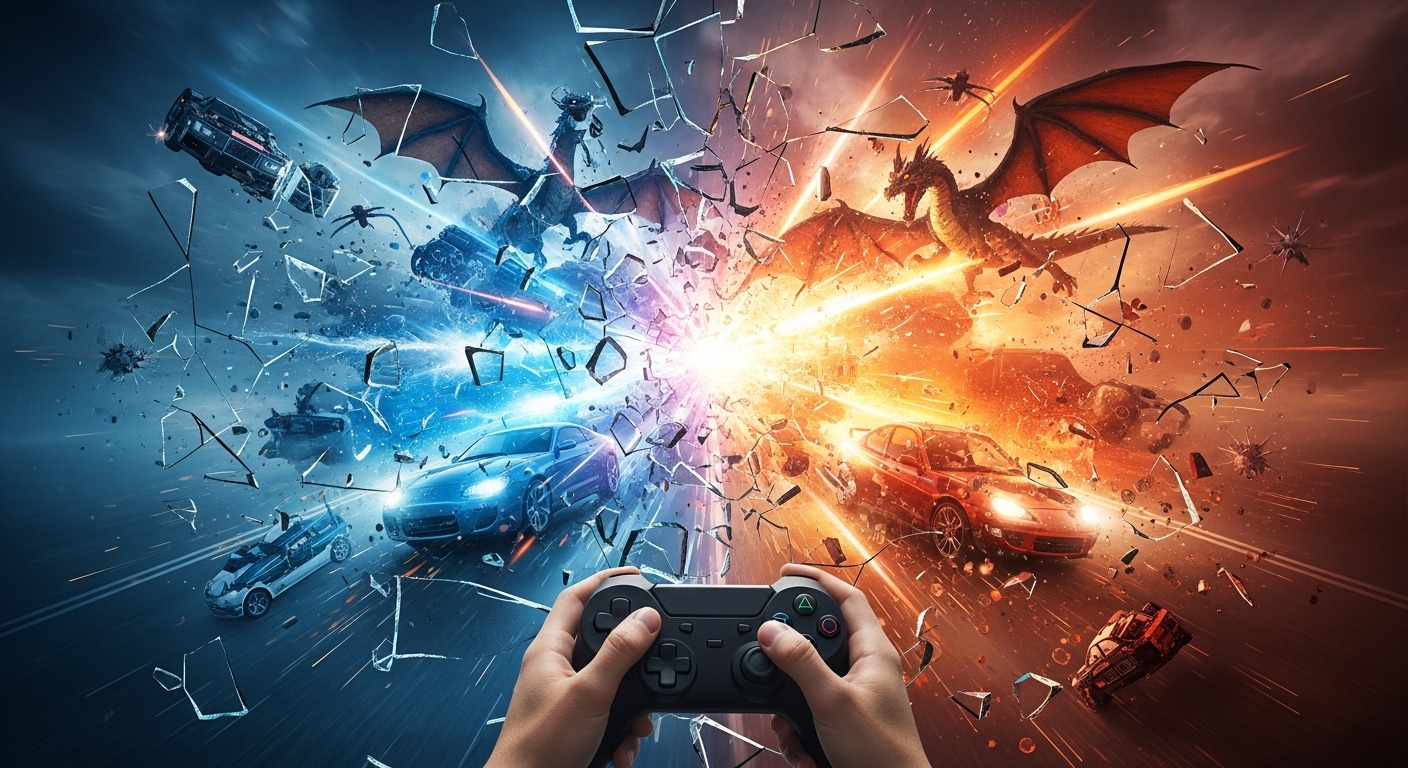The world of gaming has evolved in ways that once seemed unimaginable. What began as simple pixelated games with limited interactions has blossomed into a multi-billion-dollar industry that spans everything from mobile apps to massive online multiplayer experiences. The journey from the early days of arcade machines to today’s immersive virtual reality has been nothing short of extraordinary. In this post, we explore how gaming has changed over the years, the technological innovations driving these shifts, and what the future of gaming holds.
The Humble Beginnings: Arcade Games and Early Consoles
In the late 1970s and early 1980s, arcade games were the first taste of interactive entertainment for many people. Games like Pong, Space Invaders, and Pac-Man dominated the gaming scene, offering simple yet addictive gameplay that kept players coming back for more. The appeal was clear: they provided an escape and a way to compete, even if the graphics were primitive by today’s standards.
The transition from arcade machines to home consoles marked a major milestone in gaming history. The Atari 2600, released in 1977, allowed people to play games in the comfort of their homes, opening up a whole new world of possibilities. Early console games were rudimentary, but they laid the foundation for what was to come. The 1980s and 1990s saw consoles like the Nintendo Entertainment System (NES), Sega Genesis, and Super Nintendo revolutionize gaming, bringing us some of the most iconic franchises of all time, including Super Mario Bros., The Legend of Zelda, and Sonic the Hedgehog.
The Rise of 3D Graphics and Open Worlds
The 1990s brought about the dawn of 3D gaming. With the release of the Sony PlayStation and the Nintendo 64, gamers were introduced to fully three-dimensional environments, transforming the way games were designed and played. Titles like Super Mario 64, Final Fantasy VII, and The Legend of Zelda: Ocarina of Time pushed the boundaries of storytelling and gameplay, immersing players in vast, explorable worlds.
This era also saw the rise of “open-world” games, where players could explore large, free-roaming environments. The Elder Scrolls series, Grand Theft Auto, and Metal Gear Solid are examples of games that not only featured expansive worlds but also allowed for a high degree of player choice, making each playthrough unique.
The leap to 3D graphics didn’t just change the visual appeal of games; it also created new gameplay mechanics. For example, platformers became more intricate, shooters became more immersive, and RPGs evolved into epic, narrative-driven experiences.
The Online Revolution: Gaming Becomes Social
In the early 2000s, the world of gaming underwent a dramatic shift with the introduction of online multiplayer gaming. Broadband internet became more widely accessible, and consoles like the Xbox and PlayStation embraced online gaming as a core feature. Games like Halo 2, Call of Duty 4: Modern Warfare, and World of Warcraft allowed players to connect with others across the globe, changing gaming from a solitary activity to a social one.
Online gaming created entirely new communities, where friendships were forged, rivalries formed, and massive multiplayer experiences became the norm. World of Warcraft became a global phenomenon, with millions of players participating in large-scale raids and quests. On the console side, Halo and Call of Duty brought competitive multiplayer gaming to the forefront, establishing the foundation for eSports, where players now compete professionally for substantial cash prizes.
The rise of online gaming also led to the creation of digital storefronts like Steam, Xbox Live, and the PlayStation Network, which made it easier for gamers to download games, updates, and content directly to their consoles or PCs. This move towards digital distribution revolutionized the gaming industry, making games more accessible and reducing the need for physical copies.
Mobile Gaming: The New Frontier
While console and PC gaming have long been the mainstays of the industry, mobile gaming has surged in popularity over the past decade. With the advent of smartphones and tablets, millions of people now have access to a wide variety of games right in their pockets. Games like Angry Birds, Candy Crush Saga, and Clash of Clans reached massive audiences, proving that gaming isn’t confined to traditional platforms.
The accessibility of mobile games has also helped to expand the gaming demographic. What was once a hobby mainly for teenagers and young adults has now become a pastime for people of all ages. The casual gaming market has exploded, and it’s no longer unusual to find grandmothers and office workers competing in mobile puzzle games or strategy games.
Mobile gaming also gave rise to new genres, particularly “hyper-casual” games, which are easy to pick up and play without requiring long-term commitment. Free-to-play games with in-app purchases have become the norm, providing developers with a new way to monetize games while keeping them accessible to a wider audience.
Virtual Reality and Augmented Reality: The Future of Gaming?
As gaming continues to evolve, one of the most exciting frontiers is virtual reality (VR) and augmented reality (AR). While still in its early stages, VR gaming offers players the chance to step into entirely new worlds, experiencing games in a more immersive way than ever before. With devices like the Oculus Rift, PlayStation VR, and HTC Vive, VR is slowly but surely making its mark on the industry.
VR games like Beat Saber, Half-Life: Alyx, and Superhot VR have proven that the technology has the potential to change the way we play. Whether it’s swinging lightsabers in a music rhythm game or solving puzzles in a fully immersive environment, VR gaming offers a level of immersion that traditional gaming can’t match.
On the other hand, augmented reality (AR) is blending the real world with digital elements. Pokémon Go was one of the biggest AR successes, allowing players to catch virtual creatures in their real-world surroundings. The possibilities of AR in gaming are limitless, from interactive board games to location-based adventures that blend gaming with physical spaces.
The Rise of eSports: Competitive Gaming Goes Global
eSports has become a major player in the gaming world. Once seen as a niche hobby, competitive gaming is now a multi-million-dollar industry with professional teams, streaming platforms, and global tournaments. Games like League of Legends, Dota 2, Fortnite, and Overwatch have turned competitive gaming into a spectator sport, with millions of fans tuning in to watch professional players battle it out for cash prizes and fame.
eSports events now fill arenas, and the best players are treated like celebrities, with sponsorships, media deals, and endorsement opportunities. The industry has also created new career paths for gamers, from professional players to streamers and commentators. Major companies like Intel, Red Bull, and Coca-Cola are investing heavily in the eSports space, recognizing the immense potential for growth.
Additionally, streaming platforms like Twitch and YouTube Gaming have allowed players to build massive followings, turning gaming into a legitimate career for many. The rise of eSports is reshaping the way we think about gaming, making it as mainstream as traditional sports.
The Future of Gaming: What’s Next?
The future of gaming is an exciting one, with technology continuing to evolve at a rapid pace. We can expect even more immersive experiences, thanks to advances in AI, VR, and cloud gaming. The rise of 5G technology will also enhance online gaming, making it faster and more stable than ever before. Cloud gaming services like Google Stadia and Microsoft’s xCloud are already starting to change the way games are delivered, allowing players to stream high-quality games without the need for expensive hardware.
Artificial intelligence will also continue to play a significant role in gaming, enhancing NPC behavior, creating dynamic storylines, and offering players more personalized experiences. We may see games that adapt to individual playstyles and provide challenges tailored to each player’s skill level.
As gaming continues to evolve, one thing is clear: it will remain an essential form of entertainment and a platform for creativity, competition, and community for years to come.
Conclusion: Gaming’s Ever-Growing Influence
From humble beginnings to the high-tech, global phenomenon it is today, gaming has come a long way. What was once a pastime enjoyed by a select group of enthusiasts is now a cultural force that connects people worldwide. As technology continues to advance, the possibilities for gaming are endless. Whether through virtual reality, eSports, or mobile platforms, gaming is poised to keep evolving, offering new experiences and opportunities for players and developers alike. The future of gaming is bright, and it’s just getting started.




